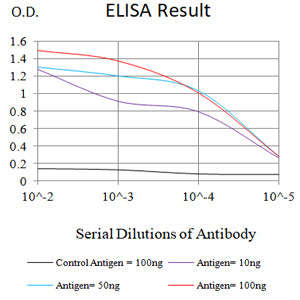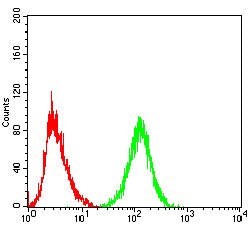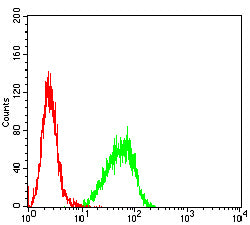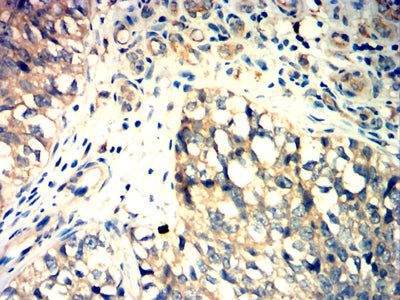



| WB | 咨询技术 | Human,Mouse,Rat |
| IF | 咨询技术 | Human,Mouse,Rat |
| IHC | 1/200 - 1/1000 | Human,Mouse,Rat |
| ICC | 技术咨询 | Human,Mouse,Rat |
| FCM | 1/200 - 1/400 | Human,Mouse,Rat |
| Elisa | 1/10000 | Human,Mouse,Rat |
| Aliases | BFPP; BPPR; ADGRG1; TM7LN4; TM7XN1 |
| Entrez GeneID | 9289 |
| clone | 3A1D7 |
| WB Predicted band size | 77.7kDa |
| Host/Isotype | Mouse IgG1 |
| Antibody Type | Primary antibody |
| Storage | Store at 4°C short term. Aliquot and store at -20°C long term. Avoid freeze/thaw cycles. |
| Species Reactivity | Human |
| Immunogen | Purified recombinant fragment of human GPR56 (AA: extra(26-225)) expressed in E. Coli. |
| Formulation | Purified antibody in PBS with 0.05% sodium azide |
+ +
以下是关于GPR56抗体的3篇参考文献及其摘要概括:
---
1. **文献名称**: *GPR56 regulates VEGF production and angiogenesis during melanoma progression*
**作者**: Iguchi, T., et al.
**摘要**: 该研究利用特异性GPR56抗体,通过免疫组化和Western blot技术,揭示GPR56在黑色素瘤中通过调控VEGF信号通路影响肿瘤血管生成。抗体实验证实GPR56高表达与患者预后不良相关。
---
2. **文献名称**: *Proteolytic cleavage of GPR56 by the serine protease matriptase alters its signaling properties*
**作者**: Luo, R., et al.
**摘要**: 作者开发了针对GPR56胞外结构域的多克隆抗体,发现其在不同组织中的剪切形式。抗体用于检测GPR56的蛋白水解过程,证明剪切后影响其介导的细胞黏附功能。
---
3. **文献名称**: *GPR56 is highly expressed in hematopoietic stem cells and maintains quiescence through interaction with TSPAN3*
**作者**: Saito, Y., et al.
**摘要**: 通过流式细胞术(使用抗GPR56抗体)和基因敲除模型,研究发现GPR56在造血干细胞静息状态中的关键作用,抗体证实其与TSPAN3互作调控Wnt信号通路。
---
这些文献均涉及GPR56抗体的实验应用,涵盖肿瘤生物学、蛋白功能及干细胞研究领域。如需具体文章年份或期刊,可进一步补充检索。
×